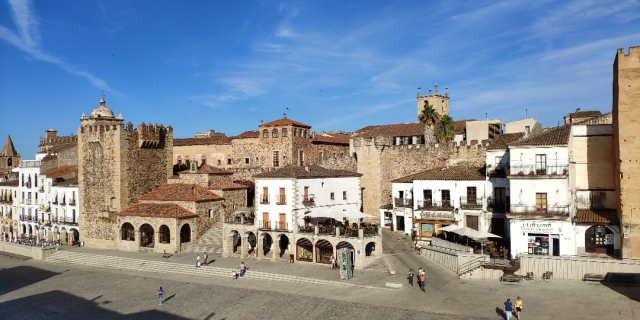Camino de Santiago from Cáceres: Pilgrims' Roads to Santiago de Compostela in the Western Peninsula
The Jacobean Ways of the Western Peninsular aim to preserve and disseminate other ways of reaching the Galician capital.
Why do the Camino de Santiago from Cáceres?
One of the most popular routes of the Camino de Santiago and of all the existing Jacobean routes is, without any doubt, the Vía de la Plata. This road runs along an ancient Roman road that crosses the western part of the Iberian Peninsula from south to north. It starts in Seville and after 27 stages of a total of more than 700 kilometers, it ends in Astorga and joins the French Way. If you want to enjoy all that this historic route has to offer, Cáceres is one of the best starting points.
Thousands of pilgrims choose to follow the Camino de Santiago from Cáceres. The reasons are many and varied, since the Vía de la Plata is not the only way to reach Santiago de Compostela. There are other Jacobean routes to the west of the peninsula with a cultural richness that includes hundreds of years of history; endless panoramic views, bridges built by the Romans, buildings and architectural monuments of great relevance and nature wherever you look.
The Jacobean Ways of the Western Peninsular aim to preserve and disseminate other ways of reaching the Galician capital. The Via de la Estrella and the Camino de Galisteo a Riomalo de Abajo not only have a great historical value with many monuments and buildings considered World Heritage Sites, but also cooperate with Portugal to offer pilgrims two very attractive options.
What to take into account if we do the Way of St. James from Cáceres?
Although the Vía de la Plata passes through some essential monumental cities and conveys a Jacobean experience very different from the rest of the routes, the Vía de la Estrella is a second alternative to reach Santiago de Compostela from Cáceres. Its name comes from the famous "Arco de la Estrella" (the main entrance to the walled city) and for coinciding with the Milky Way.
Starting from the Silver Route, the Via de la Estrella connects with a beautiful Roman route that links Mérida, Cáceres and Braga, where it connects with the Portuguese Way. The route corresponds to the ancient road "Iter ab Emerita Bracaram", which links Emerita Augusta (Merida) and Norba Caesarina (Caceres) with Bracara Augusta (Braga). Along the way, pilgrims cross iconic places such as Los Barruecos, the natural park of the Tajo or the Natural Park of the Sierra de la Estrella and other privileged areas where there is a great Roman historical heritage.
On the other hand, and as a third option, pilgrims on the Camino de Santiago from Cáceres can also opt for the Camino de Galisteo a Riomalo de Abajo, a Jacobean route to the west of the peninsula that runs parallel to the Vía de la Plata. Starting from Galisteo and ending in Meandro del Melero, it also links with the Portuguese Way and visits different natural attractions.
Stages of the Way of St. James from Cáceres
Cáceres is one of the most remarkable destinations of the Silver Route, since in its streets we find numerous monuments and buildings of great historical value both from the Middle Ages and the Renaissance period. In general, this route goes from Seville to Astorga, but it can be perfectly started from Cáceres.
- Stage 1: Cáceres - Alcántara Reservoir (33.8 km)
- Stage 2: Alcántara Reservoir - Grimaldo (20.0 km)
- Stage 3: Grimaldo - Carcaboso (30.2 km)
- Stage 4: Carcaboso - Aldeanueva del Camino (38.3 km)
- Stage 5: Aldeanueva del Camino - La Calzada de Béjar (21.8 km)
- Stage 6: La Calzada de Béjar - Fuenterroble de Salvatierra (20.2 km)
- Stage 7: Fuenterroble de Salvatierra - San Pedro de Rozados
- Stage 8: San Pedro de Rozados - Salamanca (23 km)
- Stage 9: Salamanca - El Cubo de la Tierra del Vino (36.4 km)
- Stage 10: El Cubo de la Tierra del Vino - Zamora (31.8 km)
- Stage 11: Zamora - Montamarta (18.6 km)
- Stage 12: Montamarta - Granja de la Moreruela (22.9 km) You can continue along the Camino Sanabrés.
- Stage 13: Granja de la Moreruela - Benavente (27.2 km)
- Stage 14: Benavente - Alija del Infantado (20.5 km)
- Stage 15: Alija del Infantado - La Bañeza (22.1 km)
- Stage 16: La Bañeza - Astorga (24.2 km)
(Continue along the French Way to Santiago de Compostela
Routes
Blog
 ¿Vas a hacer el camino de Santiago? Cuida tus pies antes y después
¿Vas a hacer el camino de Santiago? Cuida tus pies antes y después
 5 razones por las que contratar un seguro de viajes
5 razones por las que contratar un seguro de viajes
 Formas de hacer un logotipo
Formas de hacer un logotipo
 La importancia del registro de llamadas durante tu viaje por el Camino de Santiago
La importancia del registro de llamadas durante tu viaje por el Camino de Santiago
Information
Points of interest
Cities & Towns | Hostels | Lodgings | Restaurants | Saddlery | Doctors | Points of interest | Bikes workshop
Contact us | Privacy policy | Cookies policy | | Terms of use | Authorship | Web Map | Consentimiento
© Copyright LA VOZ DE GALICIA S.A. Polígono de Sabón, Arteixo, A CORUÑA (ESPAÑA) Inscrita en el Registro Mercantil de A Coruña en el Tomo 2438 del Archivo, Sección General, a los folios 91 y siguientes, hoja C-2141. CIF: A-15000649
